Pin Nailer vs Brad Nailer: Differences & Which to Use
What’s the difference between a pin nailer and a brad nailer? I’ll break down the pros and cons, when to use each one, and which is best for your needs.
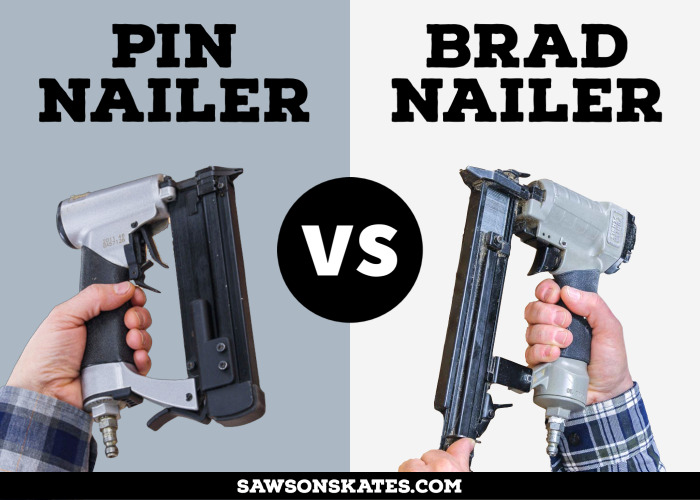
Pin nailers and brad nailers seem like similar tools, but they differ in strength and the size of nails they use.
Which of these offers the most holding power? Which one is the most versatile? Which one should you buy? Learn the distinctions between them and how to pick the right one for your DIY projects in this side-by-side comparison.
This tutorial contains affiliate links to supplies and tools. Purchases made using these links help support the Saws on Skates website and allows me to share more projects and tips with you. There is no cost to you for using these links. Visit my site policies for more information.
Table of Contents
- Pin Nailer vs Brad Nailer: What’s the Difference?
- What is a Pin Nailer?
- What is a Brad Nailer?
- Pneumatic vs Cordless
- Comparison Chart
- Which One Should You Choose?
- Frequently Asked Questions
Pin Nailer vs Brad Nailer: What’s the Difference?
Pin nailers and brad nailers have a few key differences, but they also share some things in common. For example, they both drive nails into wood, only leaving a small nail hole behind.
They’re not commonly used to build things. Instead, they’re used for finishing work on do-it-yourself projects, woodworking projects, and home improvement projects.
Some of the differences between these tools include the type of nail they use, the holding power, and the type of material you can join with them.
Nail Size and Length
The biggest difference between a brad nailer and a finish nailer is the size of the nail they use. Pin nailers use 23-gauge nails, while brad nailers use 18-gauge nails.
The amount of nails that fit within an inch is known as the gauge. The smaller the nail, the higher its gauge. For example, you can fit 23 nails per inch with a 23-gauge nail. However, with larger 18-gauge nails, you can only fit 18 per inch.
The advantage of using these small gauge nails is that they can be driven without splitting the wood.
Pin nails and brad nails come in a range of lengths. Most pin nailers accept ⅜” to 1″ nails, but some models can accommodate up to 2″ nails. Brad nailers use ⅜” to 2″ nails.
In the photo below, you can see the size difference between a brad nail (closest to the pencil) and the size of a pin nail (farthest from the pencil).
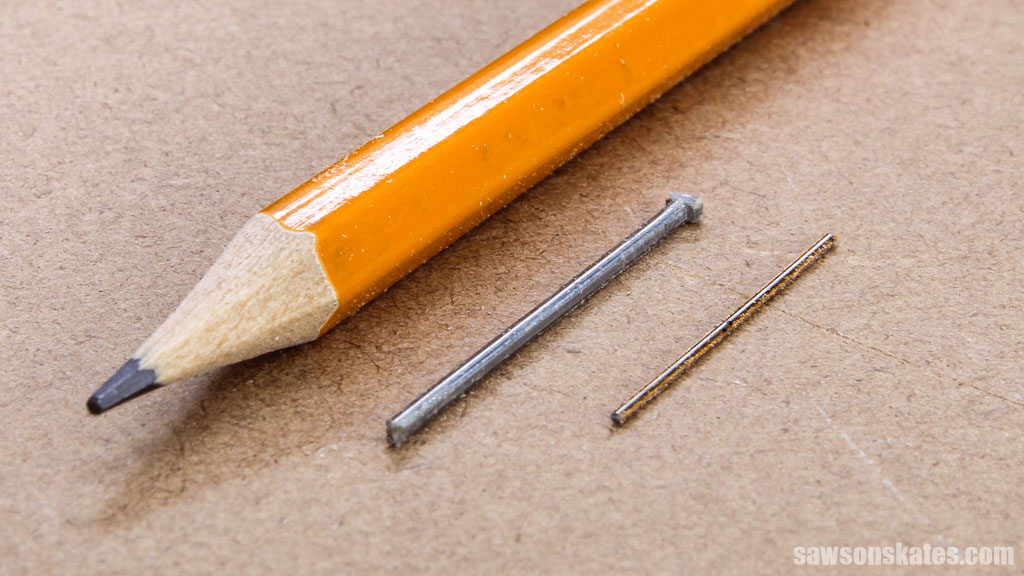
Nail Type
Pin nailers use tiny headless nails that are similar in diameter to sewing pins. Brad nailers use small wire-like nails with a t-shaped head that are larger than pin nails.
Pin nail holes are tiny and virtually unnoticeable, so you don’t have to fill them with wood filler.
Related: Does Stainable Wood Filler Work? (Here’s the Answer)
A brad nail produces a larger hole than a pin nail. Some do-it-yourselfers say that brad nail holes aren’t noticeable and don’t require filling. That said, I think brad nailers create visible nail holes, so I usually fill them for my projects.
Holding Power
Pin nailers use headless nails that have little holding power. On their own, pin nails can only make a temporary connection. Pins should be used in conjunction with wood glue to make a permanent connection. The pin nail is used to tack the workpiece where you want it and serves as a clamp to hold it in place until the glue dries.
The advantage of a brad nail is the t-shaped head which has more holding power than a pin nail and can make a permanent connection.
Material Type
The small gauge nails used by pin nailers and brad nailers struggle with joining thicker materials like plywood or MDF.
Pin nailers are most useful for fastening thin materials like veneers and delicate trim pieces to furniture.
Brad nailers are ideal for trim work like attaching lightweight molding on cabinets, decorative molding on furniture, quarter round, shoe molding, and door stop molding.
Back to Table of ContentsWhat is a Pin Nailer?
A pin nailer is a small, handheld power tool used to drive tiny, slender nails into wood. It’s the smallest power nailer available. It uses small 23-gauge headless nails that look similar to a sewing pin. Most 23-gauge pin nailers use ⅜-inch to 1-inch nails, but some can accommodate up to 2-inch nails.
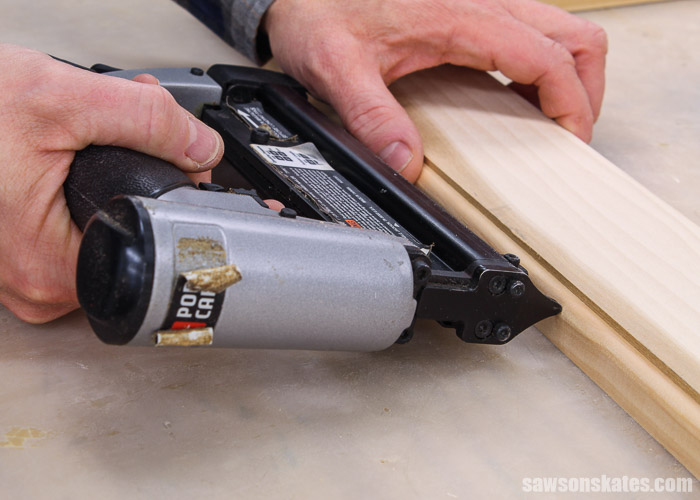
Advantages of a Pin Nailer
The small diameter of pin nails rarely causes wood to split, making them a great choice for attaching delicate pieces of wood trim and thin pieces of wood veneer.
Another benefit is pin nail holes are nearly invisible and don’t require wood filler.
Related: Wood Putty vs Wood Filler: Which to Use & Why
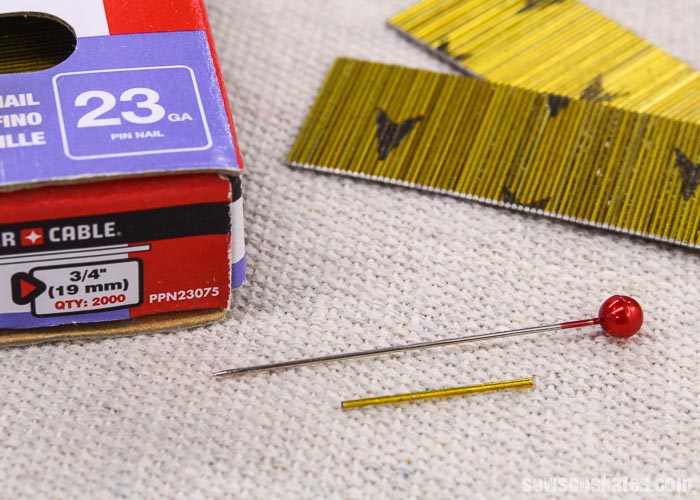
Disadvantages of a Pin Nailer
Because pin nails have little holding power and can only make a temporary connection on their own, they have limited uses.
Back to Table of ContentsWhen to Use a Pin Nailer?
Pin nailers work best for very fine finishing work. Unlike other nails, Pin nails are not used as the primary connection for workpieces. Instead, they are used in combination with wood glue to tack workpieces in place while the glue dries.
Pin nails must be used with wood glue to create a permanent connection.
Pin nailers are best suited for attaching workpieces where larger nails could split the wood:
- Delicate wood pieces
- Intricate or tiny pieces of trim
- Thin veneers
Some do-it-yourselfers say you can use a pin nailer to install crown molding. Others say that it’s too lightweight. I think a pin nailer is too lightweight to be used for installing crown molding.
Another source of confusion about crown molding is the crown stapler, which has nothing to do with crown molding at all. Instead, a crown stapler refers to the type of fastener it uses.
Crown staplers use staples. The staples have two nail-like legs and a middle portion, known as the crown, which connects the legs.
A crown stapler is most commonly used for upholstery projects, such as attaching fabric to the wood frame of a couch or chair.
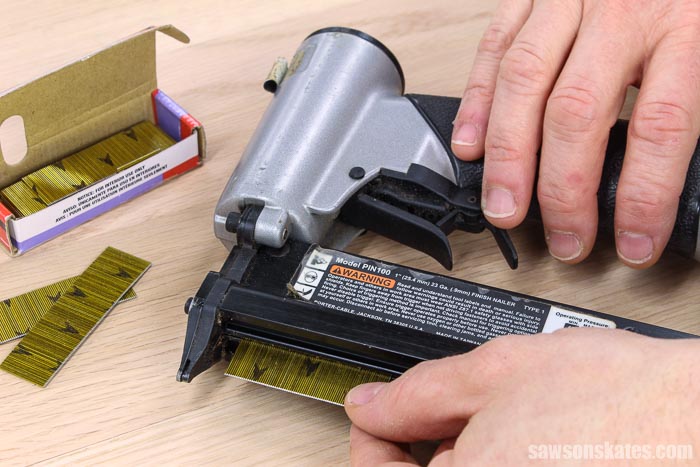
How to Use a Pin Nailer
Here’s a quick video that shows how to use a pin nailer.
What is a Brad Nailer?
A brad nailer is a tool used to drive small nails. It uses wire-like 18-gauge nails with a t-shaped head. Brad nails use 3/8″ to 2″ nails.
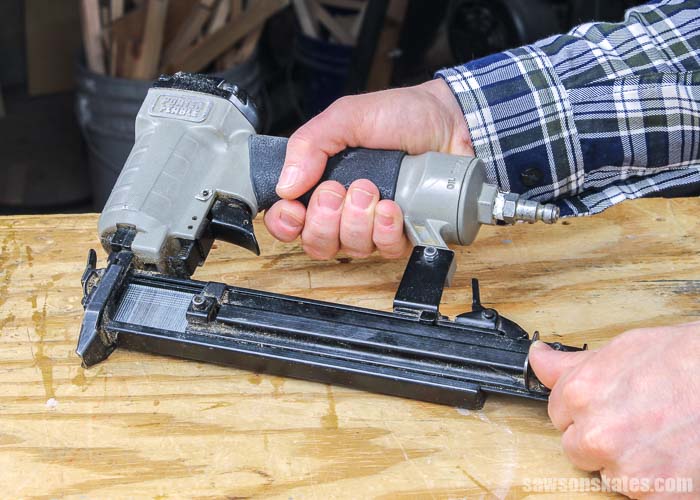
Advantages of a Brad Nailer
Brad nails offer greater holding power than a headless pin nail. Brad nails have a t-shaped head and a larger diameter, making them more useful for projects requiring additional strength like installing trim work.
Brad nailers are also more versatile than pin nailers, as they can be used for a wider range of tasks.
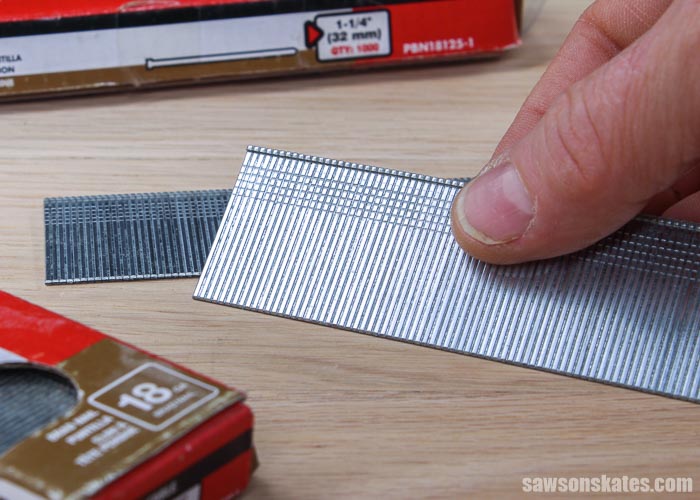
Disadvantages of a Brad Nailer
The hole produced by a brad nail is larger than the hole made by a pin nail. However, a brad nail hole is still relatively small, so some do-it-yourselfers believe that they don’t need to be filled. That said, I think brad nail holes are noticeable, so I usually fill them for my projects.
Back to Table of ContentsWhen to Use a Brad Nailer
Brad nails aren’t strong enough to hold large moldings or large boards in place, and they have a hard time going through hardwoods, MDF, and thick pieces of plywood.
Brad nailers are best suited for installing:
- Lightweight trim on cabinets and DIY furniture
- Decorative molding
- Shoe molding, quarter round, and door stop molding
- Assembling picture frames
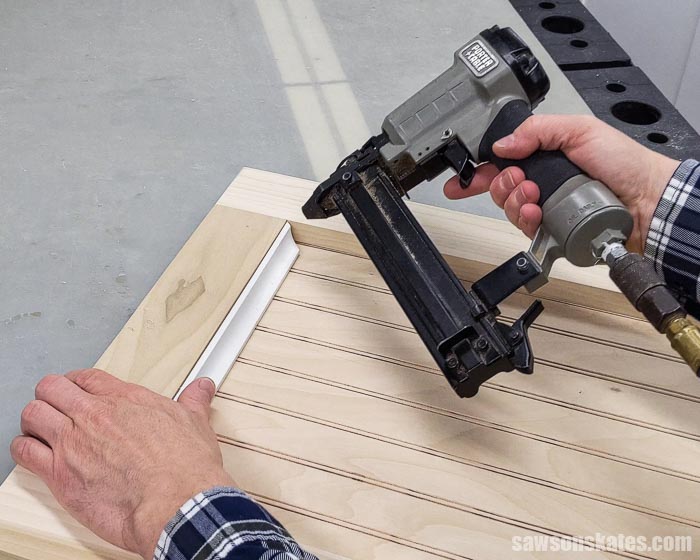
I often hear people recommending a brad nailer for installing baseboards. Instead of a brad nailer, I would use a 15-gauge or 16-gauge finish nailer for base-boarding. After the baseboard has been installed, an 18-gauge brad nailer is useful for attaching base cap and shoe molding.
Related: Brad Nailer vs Finish Nailer: Which to Choose & Why
Let’s say you want to attach some baseboard. Baseboards, crown molding, chair rail, etc., are attached over drywall. The best way to install these moldings is to drive the nails into the wall studs.
Many of these moldings are ¾” thick, and drywall is generally ½” thick, which means the nail must penetrate 1-¼” of material before reaching the stud.
The longest brad nail is 2 inches. So, if you use a 2″ brad nail to attach the baseboard, only ¾” of the nail is driven into the stud, which does not provide a lot of holding power.
However, if you use a finish nailer with 2-½” nails to attach the baseboard instead, 1-¼” of the nail will be driven into the stud, providing more holding power than a brad nail.
Back to Table of ContentsHow to Use a Brad Nailer
Here’s a quick video that shows how to use a brad nailer.
Parts of a Nailer
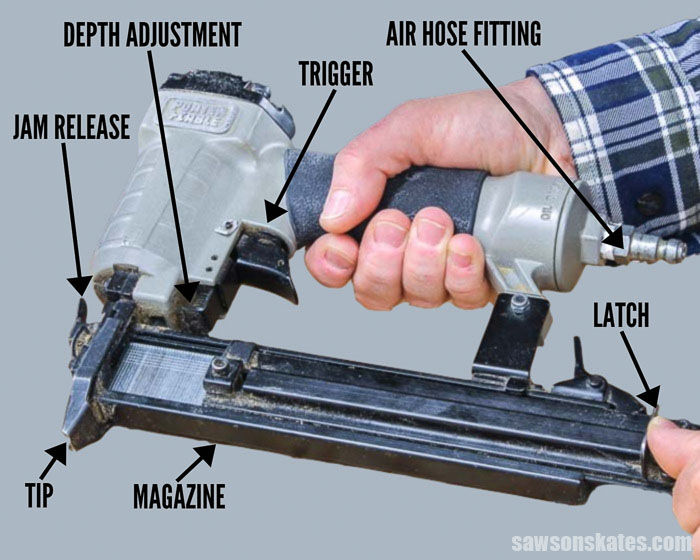
Trigger
Many nailers have a feature called a contact trigger. A contact trigger is a type of switch that allows the nailer to fire whenever the tip or nose piece, as well as the trigger, are pressed at the same time.
Depth Adjustment
Many nailers have an adjustment that allows you to fine-tune the depth of the nail without adjusting the compressor pressure.
Magazine
The magazine stores and feeds the nails to the tip of the nailer. Some magazines include a viewing window so you can tell when you’re running low on nails.
Magazine Release Latch
Nails may be inserted into the magazine when this latch is released.
Tip
Nails are discharged from the tip or nose of the nail gun. Many nailers include a safety mechanism in the tip that prevents it from firing a nail unless the nose and the trigger are pressed at the same time.
Air Hose Fitting
Pneumatic nailers, have an air hose fitting that connects the nailer to the air compressor.
Jam Release
This latch opens to let you easily remove jammed nails.
Pneumatic vs Cordless
When it comes to choosing a nailer, there are more things to consider.
Pneumatic
Pneumatic nailers use compressed air from an air compressor to drive the nails. To use a pneumatic nailer, you’ll also need an air compressor and an air compressor hose.
The benefit of using a pneumatic nailer is that you can continue to work as long as the compressor is connected to a power source.
Pneumatic nailers have a few drawbacks. Compressors may be noisy, and air hoses can get caught on everything from workbenches to ladders, which is inconvenient. Plus, dragging the weight of the air hose may be exhausting on your arms if you’re working overhead.
Cordless
Rechargeable batteries are used in cordless nailers. You can continue working as long as the battery is charged, but you’ll have to quit when the charge runs out.
Cordless nailers are convenient. There’s no need for a compressor or hose, so they can go almost anyplace. However, this flexibility comes at a cost. Cordless nailers are generally more expensive than pneumatic nailers.
Back to Table of ContentsPin Nailer vs Brad Nailer Comparison Chart
| Pin Nailer | Brad Nailer | |
|---|---|---|
| Gauge | 23-gauge | 18-gauge |
| Nail Length | ⅜” to 1″ some up to 2″ | ⅜” to 2″ |
| Nail Type | Headless | T-shaped |
| Holding Power | Temporary connection without glue | Permanent connection |
| Material | Delicate trim and veneer | Lightweight molding |
Which One Should You Choose?
If you’re still not sure whether to get a pin nailer or a brad nailer, go with a brad nailer. Brad nailers are more versatile, have greater holding power, and can be used for a wider range of tasks than pin nailers.
Combo kits containing both nailers are occasionally available. A combination kit is a smart investment if it’s within your budget because you will save money by purchasing both nailers at once.
I purchased my nailers separately. I got my brad nailer at a woodworking auction for a really good price. It was in excellent condition and cost a fraction of a new one.
Later on, I bought my pin nailer to attach some thin pieces of trim on a furniture project.
Related: How to Buy Used Tools
Back to Table of ContentsFrequently Asked Questions
Can you use a pin nailer to attach baseboards?
No, baseboards cannot be attached with a pin nailer. Headless nails aren’t powerful enough to hold baseboards in place. For installing baseboards, a 15-gauge or 16-gauge finish nailer is a better choice than a pin nailer.
Can I use pin nails for crown molding?
No, pin nails lack the strength to hold crown molding in place. 15-gauge or 16-gauge finish nails are a better option for crown molding installation.
What would you use a pin nailer for?
Pin nailers are ideal for attaching workpieces where larger nails could split the wood, like installing delicate or tiny pieces of trim and thin veneers. They’re also useful when you need to tack a workpiece in place temporarily.
Can you use pin nails in a brad nailer?
No, pin nails are too small to be used in a brad nailer. A brad nailer uses larger diameter, 18-gauge nails, whereas a pin nail is a smaller diameter, 23-gauge headless nail. If you try to use a pin nail in a brad nailer, the tool will not operate, or the nails will get jammed.
Back to Table of ContentsFinal Thoughts
Pin nailers and brad nailers both drive nails into wood, but they have some key differences.
A pin nailer uses tiny headless nails that have little holding power. A brad nailer uses small t-shaped nails with greater holding power and can be used on a broader range of projects than a pin nailer.
Between the two, a brad nailer is a more versatile tool.
Thank you for stopping by. If you enjoyed this tutorial, would you please take a moment and pin it to Pinterest? I’d really appreciate it!







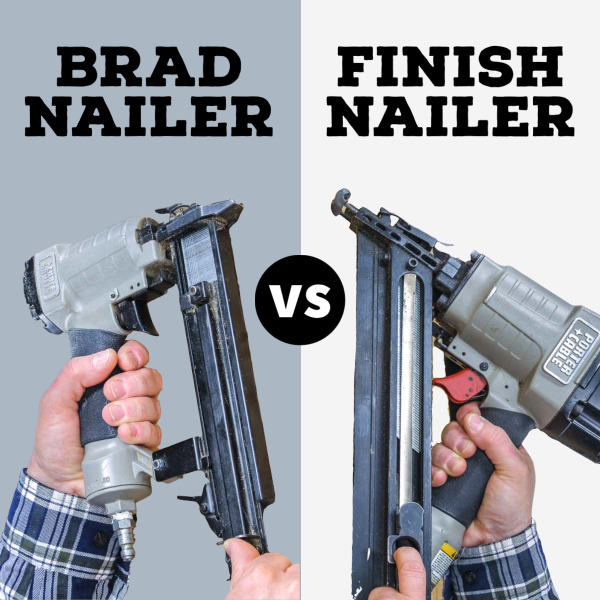
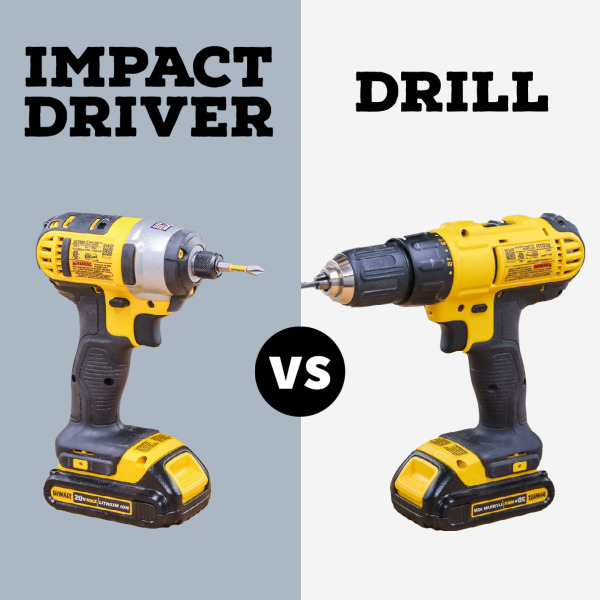
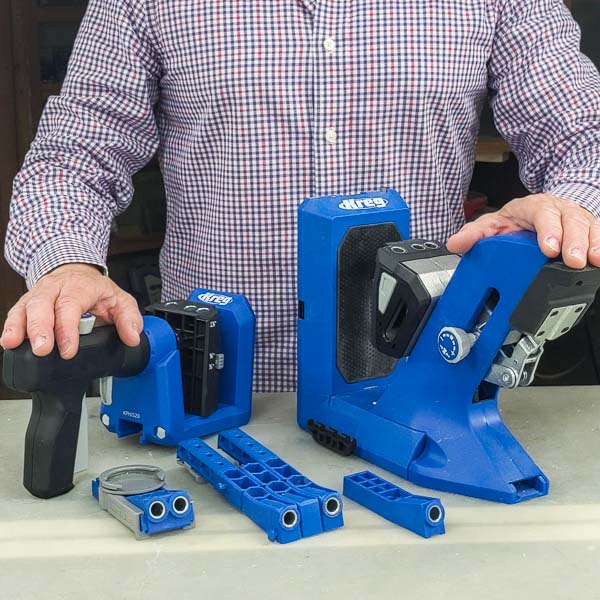

Excellent information and videos. I learned everything I needed to know 💯
Thanks! Seeing the size of the actual fasteners was exactly what I needed. Good explanations too.
You’re welcome. I’m glad it was helpful!